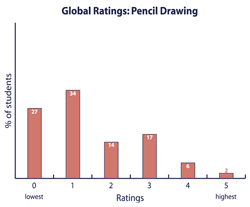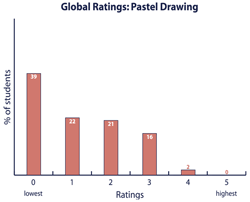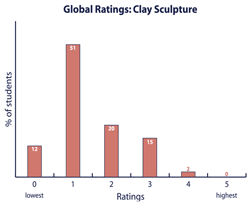|
|
: Link Tasks | |
|
|
||
| Link Task 2 : Pastel Drawing | ||||||||||
|
||||||||||
| Questions/instructions:
After listening to a stimulus poem, students were asked to make a picture to depict the character in the poem. They were instructed to try to use the pastels in ways that make colours and shapes bright, bold and colourful. |
||||||||||
| Mean Score | ||||||||||
| Key attributes: (0 low – 3 high) | ||||||||||
| expressiveness:
image appropriate to task; strength, vitality and colour; movement, dynamism, imagination, avoidance of cliché |
0.82 |
|||||||||
| compostion: use of pictorial space; appropriate context; arrangement of images; balance |
0.98 |
|||||||||
| detail: finer features included |
0.82 |
|||||||||
| use
of media: technical control of pastel media to achieve a range of mark making |
0.96 |
|||||||||
| Global
rating: (0 low – 5 high) |
||||||||||
| Link Task 3 : Clay Sculpture | ||||||||||
|
||||||||||
| Questions/instructions:
Students were asked to make an object from clay and to position it on the wooden structure. The opportunity was given for planning the object by making a pencil sketch prior to modelling. |
||||||||||
| Mean Score | ||||||||||
|
[click
on graph for enlargement]
|
Key attributes: (0 low – 3 high) | |||||||||
| expressiveness: appearance and effect of the image and its persona |
1.07 |
|||||||||
| composition:
use of available clay; the ‘fit’ of object with structure; 3-dimensional qualities |
1.16 |
|||||||||
| detail:
appropriate features and embellishments |
0.90 |
|||||||||
| structural
skills: moulding and joining; stability |
1.00 |
|||||||||
| Global
rating: (0 low – 5 high) |
||||||||||
| Link Task 4 | |||
|
|||
| Focus: Students can identify and interpret particular features depicted in paintings. | |||
| Resources:Picture. | |||
| Questions/instructions:
Students were shown pictures of an artist’s paintings and asked to identify general features and characteristics particular to New Zealand. |
|||
| % responses | |||
| Descriptions of features of painted characters: | |||
2
or more appropriate features, well explained |
6 |
||
2
or more appropriate features, but little explanation |
63 |
||
1
appropriate feature, well explained |
2 |
||
1
appropriate feature, but little explanation |
17 |
||
any
other response |
12 |
||
| Identification
of features that give paintedcharacters a special New Zealand identity: |
|||
2
or more appropriate features, well explained |
10 |
||
2
or more appropriate features, but little explanation |
76 |
||
1
appropriate feature, well explained |
0 |
||
1
appropriate feature, but little explanation |
6 |
||
any
other response |
8 |
||
| Link Task 5 | |||
|
|||
| Focus: Students can form their own viewpoint on an artwork after considering others’ viewpoints. | |||
| Resources:Video on laptop computer, picture. | |||
| Questions/instructions:
Students watched a video clip showing the installation and display of an artist’s work in a public place. |
|||
| % responses | |||
|
Explanation
of reasons for liking or disliking the artist’s work: |
|||
|
strong
reaction, well explained |
0 |
||
|
strong
reaction, but not well explained |
2 |
||
|
moderate
reaction, with some explanation |
39 |
||
|
moderate
reaction, with no explanation |
53 |
||
|
any
other response (including “I don’t know”)
|
6 |
||
|
Evaluations
of people’s differentpreferences for the artist’s work: |
|||
|
identified
differences and explained that people have different preferences |
7 |
||
|
identified
differences but did not explain why people have different preferences
|
30 |
||
|
did
not clearly identify the differences, or explained that people have
different preferences |
28 |
||
|
any
other response |
35 |
||
|
Agreement
with others’ preference, and reasons: |
|||
|
clear
preference, well explained |
0 |
||
|
clear
preference, not well explained |
11 |
||
|
partial
agreement with both, well explained |
76 |
||
|
partial
agreement with both, but not well explained |
0 |
||
|
any
other response |
13 |
||
| Link Task 6 | |||
|
|||
| Focus: Students can identify and discuss the features and uses of a carving. | |||
| Resources:Small carving. | |||
| Questions/instructions:
Students were asked to interpret and describe a carving, explain how it was made, and consider its appeal to others. |
|||
| % responses | |||
| Identification of shape: | |||
| specifically
correct |
51 |
||
generally
correct |
34 |
||
any
other response |
15 |
||
| Identification of materials used: | |||
first
correct option |
72 |
||
second
correct option |
0 |
||
any
other response |
28 |
||
| Identification of steps followed in the process of making the carving: | |||
6
or more steps mentioned |
0 |
||
4–5
mentioned |
0 |
||
2–3
mentioned |
41 |
||
1
mentioned |
29 |
||
any
other response |
30 |
||
| Identification of people who might use the carving, and why: | |||
first
category of people |
43 |
||
second
category of people |
4 |
||
third
category of people |
30 |
||


